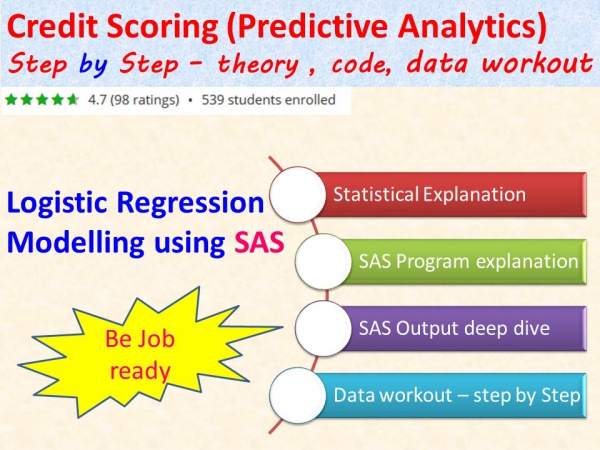
--
Analytics is a buzz word at present. It gives a competitive edge to business. It is high in demand and short in supply at present. Due to which salaries in the analytics domain are on the higher side. Many people from IT / Sales/ Marketing etc. want to make their career transition into analytics.
Here is the listing of topic, it’s applicability and how people can make master these areas of analytics with almost nil dent on their pocket.
-Predictive analytics : Credit scoring – logistic regression is one of the most used technique in the industry for credit scoring. The technique is applicable in predicting risk (who will default), response (who will take offer), collectibility (who will make payment of delinquent balance) etc. SAS is a global leader for developing predictive models. The link Credit scoring using SAS points to a tutorial, which is one of the most authentic source to learn logistic regression modelling (credit scoring) using SAS. The tutorial at present carries rating of 4.7 / 5, after 100+ review. This explains econometrics / statistical theory, SAS program detail, step by step data work, deep dive into SAS output. The tutorial is quite complete in the sense that it explains every step by model building like model design, data audit guideline, variable selection (categorical and numeric), multi collinearity removal, final model development, power of a model (KS / GINI / concordance) as well as reject inference
-Predictive Analytics : Classification and regression tree (decision tree) : decision tree is one of the easiest technique of machine learning that yields tremendous benefit to the business. It has several aspects like how to develop the decision tree, how to interpret the output, how to understand it’s working, how to understand it’s business benefit. The link Decision tree using R explains how to develop decision tree using R, what is GINI / Entropy / CART / CHAID / random forest method etc. Students across the globe has found it to be too the point yet quite complete tutorial for learning decision tree
-Statistics for management – statistics has been probably one of the most difficult course to master across the globe for MBA students. It is all because it is being explained in a wrong way. Across the globe most of the faulty are not been able to simplify it for students, even if they know it in great detail. The right way of learning statistics is when one can see the demonstration of concepts through simulation of a concept and then go through the theoretical concept. The tutorial Statistics by simulation for MBAs explains statistics by simulation.
-Other analytical tools and techniques
Advance analysis using MS Excel – Excel though used by many folks but rarely people know that one can do pair T test, ANOVA, linear optimization, Linear regression, Pareto Analysis etc. using Excel. Most of the tutorial on advance excel across the globe just explains pivot table. The link on main page explain data analysis toolpak, solver and goal seek of excel. It is quite concise yet sufficiently good to help one master application of Microsoft Excel for advance analytics. This enhances one’s ability to use excel for many statistical analysis and optimization purpose.
-R programming – R is one of the best alternative of SAS. Being open source is the main advantage. R studio provides the GUI framework for writing R programs. Many constancy business banks on R to provide analytical solution. Many SAS users wants to master it because it gives them more employment options. The link on main page helps one learn R programming with comfort by working on data. It explains all the concepts through data workout rather than explaining one by the methods of lingo like vector, metrics etc. It is being liked by students as this is quite concise and gives one confidence that one can easily learn to apply it.
-Cluster analysis: is the bread and butter of marketing. It has many aspects like hierarchical clustering, non hierarchical cluster (k means clustering) and many lingo associated with the same like dendogram, scree plot, euclidean distance, simple linkage, ward method etc. The tutorial on front page is one of the easiest way to master these concepts.This explains cluster analysis using SAS along with various options of SAS, working of heirarchichal and non heirarchical algorithms, step by step explanation of SAS output, differentiation with objective segmentation techniques etc.
-Basel norms are driving global reforms in banking. The difficulty in learning these concepts are due to scattered content, which takes too much time in searching rather than going into detail of concepts. The tutorial on the link which explains basel 1, basel 2 and basel 3 step by step. It also explains why it was necessary to move to basel 2 from basel 1 and basel 3 from basel 2. It shows side by side comparison. It is one of the most concise content across the globe and quite an interesting explanation.
Release ID: 147839

